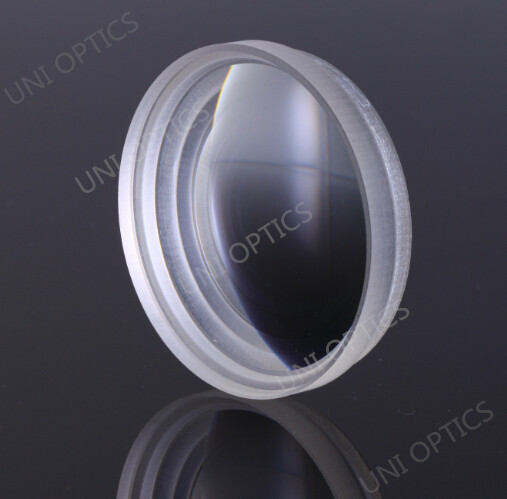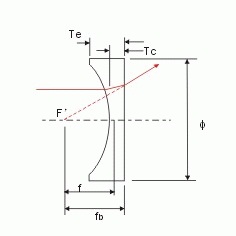平面凹透镜是光束扩散,光投影,或者扩大光学系统焦距的理想选择,它是一种焦距为负的光学透镜,具有一个凹面,平面朝向所需焦平面。平凹透镜适用于一系列的应用和各种行业。福州优恩立光电能够按客户要求为平凹透镜提供各种镀膜。
产品产地:
中国航运港口:
中国福州交付周期:
四周付款:
银行电汇, 西联付款
1. 平凹透镜的用途是什么?
平凹透镜是一种负焦距的光学透镜,它具有一个凹面,是光束扩散、光投影或扩大光学系统焦距的理想透镜,适用于一系列的应用和各种行业。福州优恩立光电能为平凹透镜提供各种镀膜选择。
2. 福州优恩立光电可以用什么材料来制作平凹透镜?
成都光明光学玻璃、肖特、OHARA、熔融石英、蓝宝石、锗、硅、氟化钙(CaF2)、硒化锌(ZnSe),以及其他红外材料等
3. 福州优恩立光电的平凹透镜制造能力如何?
参数:


设计波长:546.1nm
直径公差:+ 0/-0.05毫米
焦距公差:+/-2%
表面质量:40-20 S/D
向心性:1 弧分
表面平整度:N=3,△N=0.5
通光孔径:90%
倒边:保护性
镀膜:可选,单层氟化镁镀膜,多层宽带增透镀膜
可设计为0°入射角
| Part No. | Material | F(mm) | Φ(mm) | R(mm) | Tc(mm) | Te(mm) | Fb(mm) |
|---|---|---|---|---|---|---|---|
| UPLV008006 | BK7 | -8.0 | 6.0 | 4.15 | 2.0 | 3.30 | -9.30 |
| UPLV020006 | BK7 | -20.0 | 6.0 | -10.37 | 2.0 | 2.44 | -21.30 |
| UPLV030006 | BK7 | -30.0 | 6.0 | -15.56 | 2.0 | 2.29 | -31.32 |
| UPLV020010 | BK7 | -20.0 | 10.0 | -10.37 | 2.0 | 3.20 | -21.30 |
| UPLV030127 | BK7 | -30.0 | 12.7 | -15.56 | 2.0 | 3.40 | -31.31 |
| UPLV040127 | BK7 | -40.0 | 12.7 | -20.75 | 2.0 | 3.00 | -41.32 |
| UPLV050127 | BK7 | -50.0 | 12.7 | -25.94 | 2.0 | 2.79 | -51.33 |
| UPLV075127 | BK7 | -75.0 | 12.7 | -38.90 | 2.0 | 2.52 | -76.31 |
| UPLV100127 | BK7 | -100.0 | 12.7 | -5, 1.88 | 2.0 | 2.39 | -101.33 |
| UPLV075015 | BK7 | -75.0 | 15.0 | -38.87 | 2.0 | 2.70 | -76.30 |
| UPLV050018 | BK7 | -50.0 | 18.0 | -25.94 | 2.0 | 3.61 | -51.33 |
| UPLV075018 | BK7 | -75.0 | 18.0 | -38.90 | 2.0 | 3.05 | -76.30 |
| UPLV050254 | BK7 | -50.0 | 25.4 | -25.94 | 2.0 | 5.32 | -51.33 |
| UPLV075254 | BK7 | -75.0 | 25.4 | -38.90 | 2.0 | 4.13 | -76.31 |
| UPLV100254 | BK7 | -100.0 | 25.4 | -51.88 | 2.0 | 3.58 | -101.33 |
| UPLV150254 | BK7 | -150.0 | 25.4 | -77.80 | 2.0 | 3.04 | -151.30 |
| UPLV200254 | BK7 | -200.0 | 25.4 | -103.75 | 2.0 | 2.78 | -201.33 |
| UPLV250254 | BK7 | -250.0 | 25.4 | -129.72 | 2.0 | 2.62 | -251.39 |
| UPLV200030 | BK7 | -200.0 | 30.0 | -103.75 | 2.0 | 3.09 | -201.34 |
| UPLV100038 | BK7 | -100.0 | 38.0 | -51.88 | 2.0 | 5.60 | -101.34 |
| UPLV200038 | BK7 | -200.0 | 38.0 | -103.75 | 2.0 | 3.76 | -201.34 |
| UPLV300038 | BK7 | -300.0 | 38.0 | -155.60 | 2.0 | 3.16 | -301.30 |
| UPLV100508 | BK7 | -100.0 | 50.8 | -51.88 | 2.0 | 8.64 | -101.34 |
| UPLV200508 | BK7 | -200.0 | 50.8 | -103.75 | 2.0 | 5.16 | -201.34 |
| UPLV300508 | BK7 | -300.0 | 50.8 | -155.60 | 2.0 | 4.00 | -301.30 |
| UPLV500508 | BK7 | -500.0 | 50.8 | -259.40 | 2.0 | 3.25 | -501.40 |
| JPLV015127 | JGS1 | -15.0 | 12.7 | 6.90 | 2.0 | 6.20 | -16.40 |
| JPLV020127 | JGS1 | -20.0 | 12.7 | 9.20 | 2.0 | 4.50 | -21.40 |
| JPLV025127 | JGS1 | -25.0 | 12.7 | 11.50 | 2.0 | 3.90 | -26.40 |
| JPLV030127 | JGS1 | -30.0 | 12.7 | 13.80 | 2.0 | 3.50 | -31.40 |
| JPLV050254 | JGS1 | -50.0 | 25.4 | 23.00 | 2.0 | 5.80 | -51.40 |
| JPLV075254 | JGS1 | -75.0 | 25.4 | 34.51 | 2.0 | 4.40 | -76.40 |
| JPLV100254 | JGS1 | -100.0 | 25.4 | 46.01 | 2.0 | 3.80 | -101.40 |
| JPLV150254 | JGS1 | -150.0 | 25.4 | 69.01 | 2.0 | 3.20 | -151.40 |
| JPLV200038 | JGS1 | -200.0 | 38.0 | 92.02 | 3.0 | 5.00 | -202.10 |
| JPLV350038 | JGS1 | -350.0 | 38.0 | 161.03 | 3.0 | 4.10 | -352.10 |
| JPLV500038 | JGS1 | -500.0 | 38.0 | 230.04 | 3.0 | 3.80 | -502.10 |
| CPLV100254 | CaF2 | -100.0 | 25.4 | 42.50 | 2.0 | 3.90 | -101.40 |
| CPLV200254 | CaF2 | -200.0 | 25.4 | 85.00 | 2.0 | 3.00 | -201.40 |
| CPLV500254 | CaF2 | -500.0 | 25.4 | 212.50 | 2.0 | 2.40 | -501.40 |
上一个 :
融石英球透镜和半球透镜下一页 :
紫外熔融石英平凸透镜